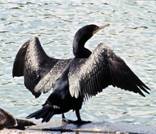|
"Your gateway to
understanding |
Double-Crested Cormorant

- New York status: Common
- The only water bird that lacks oil in their feathers
- First observed on Oneida Lake in 1984
Cormorants are medium-to-large birds with dark plumage. They may be up to 69cm (27 inches) tall, and have a 130cm (50 inch) wingspan. Adults are entirely black, but small white plumes may develop on the head during the breeding season. Juveniles have pale throats and chests that darken toward the belly, and have brownish backs and wings. Cormorants have yellow or orange colored skin on their faces, which typically becomes brighter during breeding season. Their bills have evolved to catch and eat fish, and are long, thin, and sharply hooked.
Cormorants are primarily fish-eaters, but may also eat aquatic invertebrates and even water snakes. To catch fish, cormorants make a characteristic half-jump as they dive under, giving them a more streamlined entry into the water. Under water they propel themselves with their feet. After fishing, cormorants go ashore and can be seen holding their wings out in the sun to dry. This is necessary because cormorants lack the waterproofing oils that other water birds produce. This may help them dive quickly, since the oil-less feathers do not retain air bubbles.
On Oneida Lake, cormorants nest on Wantry and Long Island. Cormorants are colonial nesters and colonies return to the same site each year. Colonies are built in rocky habitats at sites that are safe from mammalian predators. Nests are often built in trees, which are soon killed by the bird’s nitrogen rich droppings. There is usually one brood per year consisting of 3-4 chalky blue eggs. After 25-29 days of incubation, the young hatch and are fed by regurgitation. Juveniles leave the nest after 35-42 days.
Oneida Lake first saw cormorants in 1984 when a breeding pair migrated from Lake Ontario. By the year 2000, over 360 pairs of cormorants were established around the lake. This increase led to the consumption of immense numbers of sub-adult walleye and yellow perch in the 1990’s, which caused serious declines in the adult fish populations. In response to this, the New York State Department of Environmental Conservation began a cormorant management plan in 1998, and then strengthened it in 2003. The plan limits the size of the local cormorant colony to 100 birds and is also designed to keep migrating cormorants off the lake. Additionally, only 20 nests are allowed around the lake, and these are oiled to prevent the eggs from hatching. This program has been very effective in reaching its goals.
To learn more about the Cormorants ...
